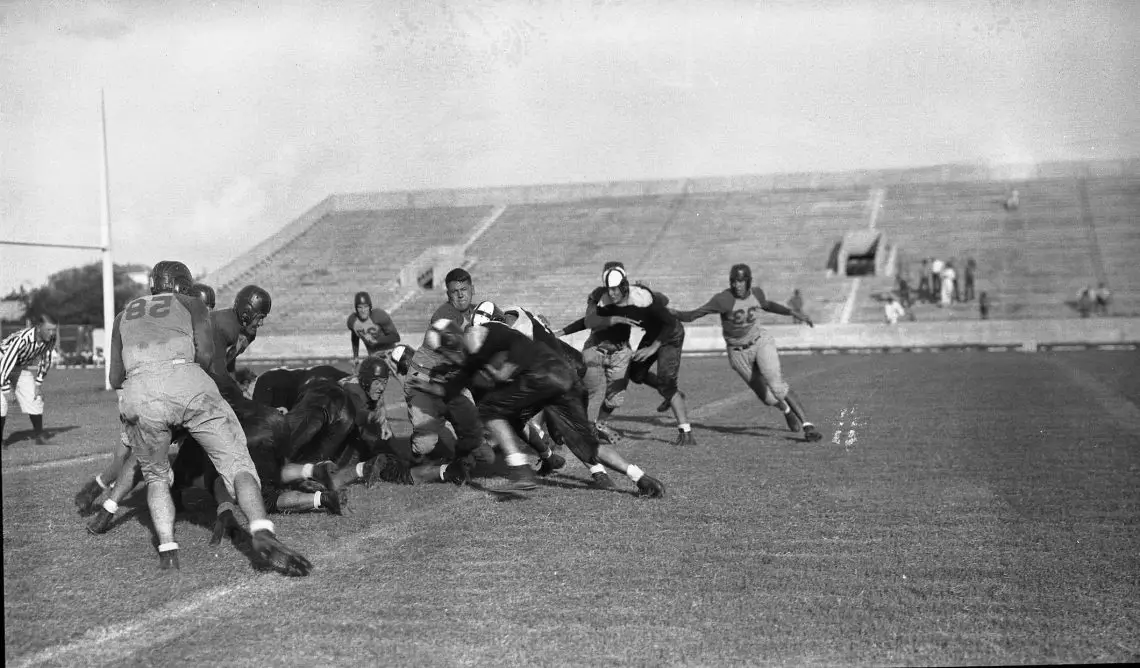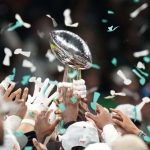
Photo: Cushing Memorial Library and Archives, Texas A&M
The thought of football without helmets is enough to make even the toughest fans squirm.
With all we know about head injuries and the prevalence of chronic traumatic encephalopathy (CTE) among football players today, it seems wild to think about playing the sport without a helmet.
While many players would step onto the field helmetless in the late nineteenth and early twentieth century, there was one who held out the longest: Eggs Manske.
When were football helmets first used?
Back when the sport started, football helmets were considered optional.
And the ones that were worn were typically made of leather and some light padding.
Helmets became mandatory in the NFL in 1943. John T. Riddel had developed the first plastic football helmet a few years earlier, but due to issues with the design, limited supplies of plastic materials during World War II and traditions within the sport, many opted for the leather helmet at this time.
It wasn’t until the 1950s that leather helmets were phased out and harder helmets similar to the ones we know today were incorporated into the game. That helped to protect players by reducing the number of injuries to the head and face.
A number of advancements were made over the years, like face masks and visors. Designers added more elements to absorb energy and reduce the force of impacts, and shock sensors were included to detect possible concussions.
But as with all innovations, there were some holdouts when helmets were first introduced. One of these old-school players, Edgar “Eggs” Manske, would go on to become the last NFL player to play without a helmet.
Eggs Manske: The last helmetless player
Eggs Manske was born in Nekoosa, Wisconsin in 1913. A standout athlete from a young age, he first made his mark in high school as a star on the basketball and football teams.
He’d go on to play both sports at Northwestern University. But football is where he really shined.
As a defensive end and receiver for Northwestern, Manske was named the most valuable player in 1933 and made several All-American teams.
His college all-star team even got a chance to play against the Chicago Bears in 1934 when they were the reigning NFL champs.
After graduating, he went on to play for the Philadelphia Eagles in 1935 and 1936. He then played for the Bears in 1937 and the Pittsburgh Pirates in 1938 before finishing out his pro career back with the Bears in 1939 and 1940.
He went out with a bang in the 1940 NFL championship against the Washington Redskins. In that historic matchup, the Bears trampled the Redskins in a 73-0 victory, which still stands as the biggest margin of victory in the league’s history.
Keeping the helmet off
Manske’s disdain for helmets became apparent in college. Manske was actually known for starting with his helmet on then ripping it off part way through the game.
He kept it up after moving to the NFL, still going helmetless even when facing tough opponents on the gridiron.
Despite the lack of head protection, Manske continued to be a star player, finishing in the top ten for receiving yards from 1935 through 1939.
Interestingly, a teammate of Manske’s is also credited with being one of the last no-helmet holdouts.
Dick Plasman, an offensive end for the Bears who also played in the memorable 1940 NFL championship, was said to be another athlete who couldn’t be bothered to wear a helmet.
He once plowed into a wall at Wrigley Field when diving for a potential touchdown pass in the end zone, his helmetless head taking the brunt of the impact.
Fortunately, his hospital stay afterward was well worth it—Plasman married his nurse.
Life after football
Fortunately, Manske’s refusal to wear a football helmet didn’t seem to affect him later in life.
After finishing his pro career, Manske was drafted for WWII. He actually got the opportunity to play football again while training at St. Mary’s Preflight School, earning All-Service All-America honors.
During the war, Manske spent three years serving in the South Pacific. After coming back to the States, he began a coaching career at Boston University and then the University of Maryland.
He eventually earned an assistant coach position at the University of California-Berkeley, accompanying the team to several Rose Bowl appearances.
Later, Manske taught biology at Berkeley High School for 20 years. Even there he collected accolades, earning an award as Berkley’s outstanding teacher.
Eggs Manske retired in 1975. He died in 2002 at the age of 89.
Helmet technology today
We’ve come a long way since the days of Manske and Plasman. The football helmet has been continuously improved over the years, providing superior protection for players.
Even today, designers are still looking for better ways to prevent head injuries on the football field. The NFL Helmet Challenge was actually developed to encourage researchers to find further improvements for this essential piece of gear.
In late 2021, three research teams were selected as the winners of this challenge based on their innovative helmet designs:
- Kollide: This team developed a helmet design with 95 different 3D-printed pads in a mesh lattice structure to help absorb impact.
- Impressio: This team came up with a design utilizing liquid-crystal elastomer (LCE) material to mimic natural body tissue and dissipate energy during impact.
- Xenith: This team’s prototype featured an outer shell that is softer in some areas and harder in others, all supported by a lattice with energy-dampening materials.
As modern football helmets are only getting better, helmetless players like Eggs Manske take on a mythic quality in the sport’s history.
Photo Credit: “Football – 1930-1939 – 104” by Cushing Memorial Library and Archives, Texas A&M is licensed under CC BY-NC-ND 2.0
